Build Muscle at Home with This Bodyweight Workout (Plus How to Eat and Train for Maximum Muscle Gains)
 By: by Amino Science
By: by Amino Science
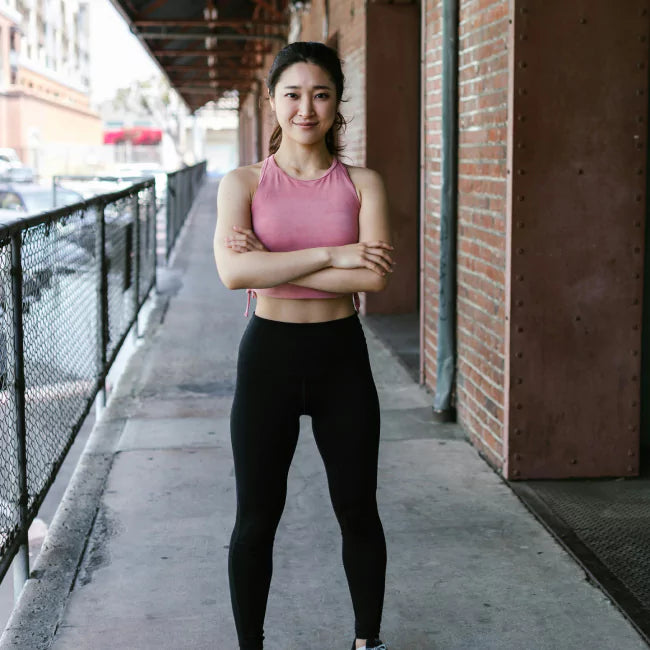
Today’s COVID climate may have you favoring home workouts over gym visits. That’s easy if it’s cardio you’re after. Go for a run, jump rope in your garage, cycle on your stationary bike to burn calories and keep your heart healthy. But if it’s muscle you’re looking to build or maintain, it becomes far more challenging to find an at-home alternative to heavy weights and machines. Difficult...but doable. In this article we’re showing you how to build muscle at home by eating right and training right, and sending you off with a bodyweight workout to start building lean muscle mass today.
Building Muscle Isn’t One Size Fits All
There’s no doubt about it. Lifting heavy leads to larger muscles.
But a heavy load isn’t the only way to bulk up.
Lifting lighter and going longer also leads to larger muscles...as long as you train to complete fatigue. Here’s the proof.
A study published in the Journal of Applied Physiology showed that strength training with a light load and more reps stimulated muscle growth as much as training with a heavier load and fewer reps (1). The trick is that you have to keep lifting until you cannot possibly do one more set.
Other studies published in the Journal of Scandinavian Medicine & Science in Sports and the Journal of Strength and Conditioning Research backed this finding up: lifting light and performing reps until complete fatigue is just as effective at building muscle as lifting heavy with fewer reps (2, 3). Great news when you’re looking to build muscle at home!
But that’s not the only way to build and maintain muscle in the absence of heavy dumbbells or a Smith machine. Slow down your tempo and you can also build as much weight as you can with heavy lifting, as evidenced by another study in the Journal of Strength and Conditioning Research (4). Participants lifted weights (concentric action) for a 3-second count and lowered weights (eccentric action) for a 3-second count and achieved just as much muscle volume and strength.
Proponents of slow lifting push the muscle gains further by lifting and lowering for 10 seconds each.
To recap: you can build muscle at home without heavy lifting using two techniques:
- Go at a normal pace but do more reps
- Go at a slower pace but do fewer reps
Both techniques stimulate mechanical overload, which in turn activates muscle growth.
Here’s how it works: When you resistance train, your muscles become fatigued and your muscle fibers have to work extra hard to complete the exercise. This exertion increases the muscle’s mechanical load and triggers muscle growth.
It’s all about the fatigue factor!
Eat Your Way to Muscle Growth
Strength training will only take you so far. Your muscles need nutrients to grow.
Muscles grow bigger through a process called muscle protein turnover. Your muscles are in a constant state of breakdown and building. During resistance training, your muscles are breaking down, and during recovery or after a protein-rich meal they are building back up.
Muscle growth occurs when you build more muscle than you break down, and the only way to do that is to eat more protein.
That’s more protein than the minimums set by the U.S. recommended daily allowance (RDA): 0.36 grams of protein for every 1 pound of body weight. But when you’re looking to build muscle or are more active than the average person you’ll need to significantly increase your protein intake closer to 1 gram per pound of body weight.
Not too hard of an ask, right? Just load your plate with protein-rich foods like wild-caught fish, grass-fed meats and dairy products, eggs, quinoa, soy, etc.
If you’re serious about building and maintaining muscle, especially when your normal weightlifting routine has been disrupted, then it’s a good idea to supplement your diet with targeted muscle-building formulas.

Supplements That Support Muscle Building
When we talk about protein as the key to muscle growth, we’re really talking about the essential amino acids that link together to form the protein. That’s all dietary protein really is—a string of amino acids linked together in a specific order.
While you could supplement with a dietary protein such as whey protein powder, it’d be far more calorically efficient to go directly to the source and supplement with free amino acids that deliver a full amino acid profile.
Science says so, including a 2017 study published in Aging Clinical and Experimental Research (5). It showed that the presence of complex carbs and fats slows the rate of intestinal absorption of essential amino acids. That’s why taking free-form essential amino acid supplements is the most effective way to optimize muscle health, strength, and growth.
What About the BCAAs?
Do a search for the top muscle-building supplements on the market and you will see BCAAs listed as one of the supremes. Science has since refuted this supremacy.
BCAAs are the branched-chain amino acids leucine, isoleucine, and valine, all of which are essential amino acids. They are called “branched-chain” because, unlike the other essential amino acids, they have a unique side chain of one carbon atom and three hydrogen atoms.
While it’s true that the BCAAs play an important role in muscle building, they cannot help you reach your maximum muscle gains without the other essential amino acids. You need a full host of essential amino acids, BCAAs and all, to get the muscle-building benefits you’re after.
That’s where the ratio of amino acids in a supplement becomes important.
You see, as we age, it becomes more difficult to build and maintain muscle. The effects of a great strength-training workout become less noticeable because our aging bodies don't respond as easily to muscle-building cues. To get your body more sensitive to the effects of resistance exercise, you can take a daily essential amino acid supplement high in leucine, which is proven to build new muscle up to 24 hours after exercise.
What About Creatine?
Your muscle cells are home to creatine, an organic compound produced by amino acids in your body. When you’re exercising, creatine gives your muscles an energy boost that helps to increase your performance and capacity.
Supplementing with creatine can help you build muscle at home because it gives you the energy you need to do more reps and increase your total mechanical load.
A meta-analysis of 22 studies shows that supplementing with creatine can:
- Boost muscle strength by as much as 20%
- Improve bench press performance by as much as 43% (6)
Another study showed that taking creatine alongside a 12-week strength-training program doubled lean body mass (7).
To get these muscle-building benefits you’d need to eat at least 5 grams of creatine a day, but the daily averages of creatine consumption fall far short at 1 gram a day for men and 0.7 grams a day for women.
If you’re looking to build muscle and improve performance, creatine may deserve a spot on your supplement shelf.
The Best All-In-One Supplement for Building Muscle
Rather than purchasing an essential amino acid supplement and a creatine supplement separately, it’d be a whole lot wiser to capitalize on the synergistic relationship between the two and invest in a muscle-building supplement that contains them both.
Developed by the leading amino acid researchers, Perform is a leucine-enriched muscle growth supplement with the precise ratio of essential amino acids needed to maximally stimulate muscle protein synthesis. And it’s bolstered by creatine!
Clinically trials show that the ingredients in Perform:
- Increase exercise completion by 20%
- Increase endurance by 22%
- Increase peak power during exercise by 11%
- Increase cognitive function during exercise by 10%
Supplementing with Perform 30 minutes before exercise and throughout activity helps to minimize muscle breakdown during exercise and maximally stimulate muscle growth after exercise, as well as increasing the production of nitric oxide.
Click here to start fueling your workouts with Perform.
And then get ready to try out our at-home equipment-free workout!
Equipment-Free Workout Plan to Build Muscle at Home
When we say equipment free we don’t mean we won’t be asking you to carry a light load. We’ll just make sure it’s items you have handy at home so you don’t have to worry about purchasing a barbell or heavy weights in order to get a full-body workout that will help you burn fat and gain muscle.
You can perform each of the body exercises below in one of two ways: either do maximum reps to fatigue, or slow the reps down to a 10-count lift and a 10-count lower.
Ready to put your gym membership on hold and be your own personal trainer? Let’s get moving with these bodyweight exercises that work all the major muscle groups!
Dynamic Warmup
First, warm up your body with a series of dynamic stretches and heart-raising exercises.
1. High Kicks
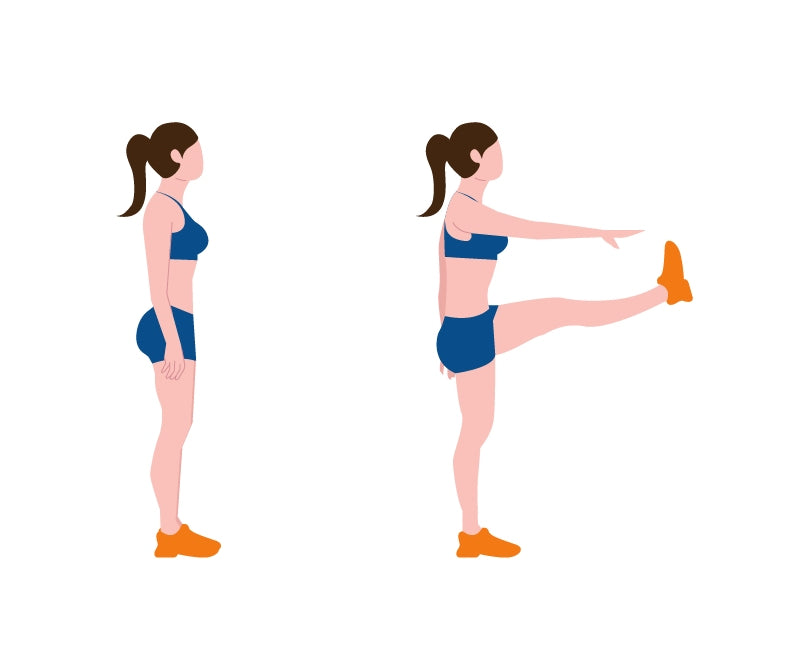
Standing tall, kick your right leg up to meet your left hand, and then kick your left leg up to meet your right hand. Keep switching side to side for 30 seconds.
2. Butt Kicks
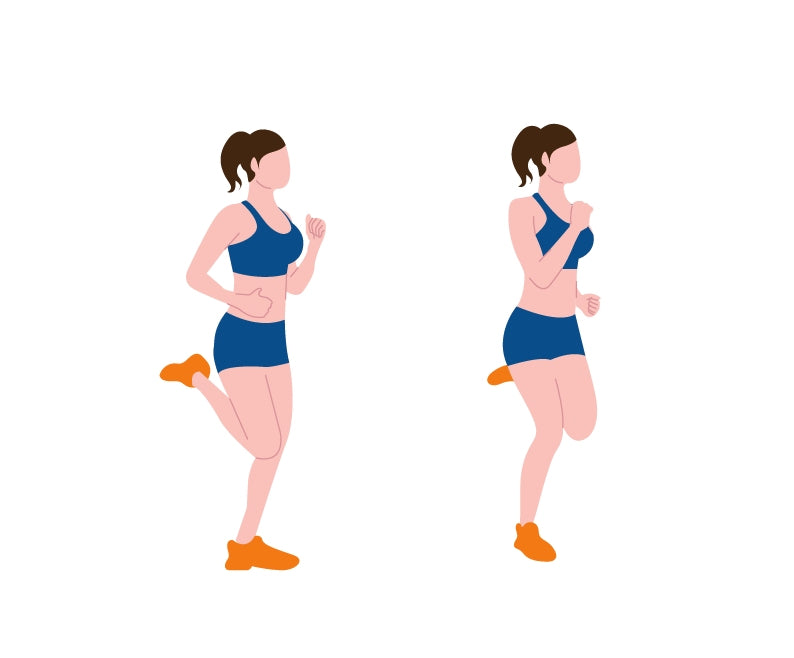
Raise your heart rate by jogging in place, kicking your heels to your butt for 30 seconds to 1 minute.
3. Jumping Jacks

Follow your butt kicks with some jumping jacks, extending your arms overhead and jumping your feet shoulder-width apart for 1 minute.
4. Lateral Lunge

Stand with your feet slightly wider than hip-width apart, toes pointing to a 45-degree angle. Lunge over your right leg, then return to center, engaging your glutes and pressing through your heal. Repeat on the left. Continue alternating for 15 reps each side.
Leg Exercises
Time to work your lower body to fatigue!
Squats
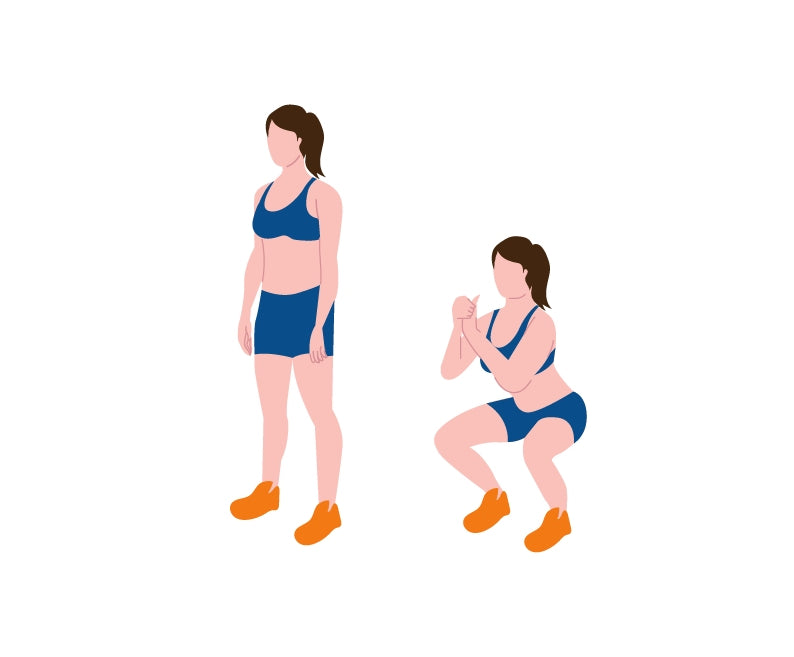
Keeping your chest lifted and your feet shoulder-width apart, bend your legs to a 90-degree angle, hold for 5-10 seconds, and press back up, engaging your glutes and your core. Aim for 30-50 squats.
When you’ve perfected the squat, add some weights. If you don’t have dumbbells or kettlebells, then grab a jug of water to hold as you squat!
Jumping Lunges
If you’re not into plyometrics, then you can also do a simple front lunge and load it up by holding a heavy book or two.
Start from a lunge position with your right foot forward and your left leg back. Jump off the ground by springing up off your back toes and driving up with your front leg. Alternate legs for 30 seconds to 1 minute.
Lateral Lunge Deadlift
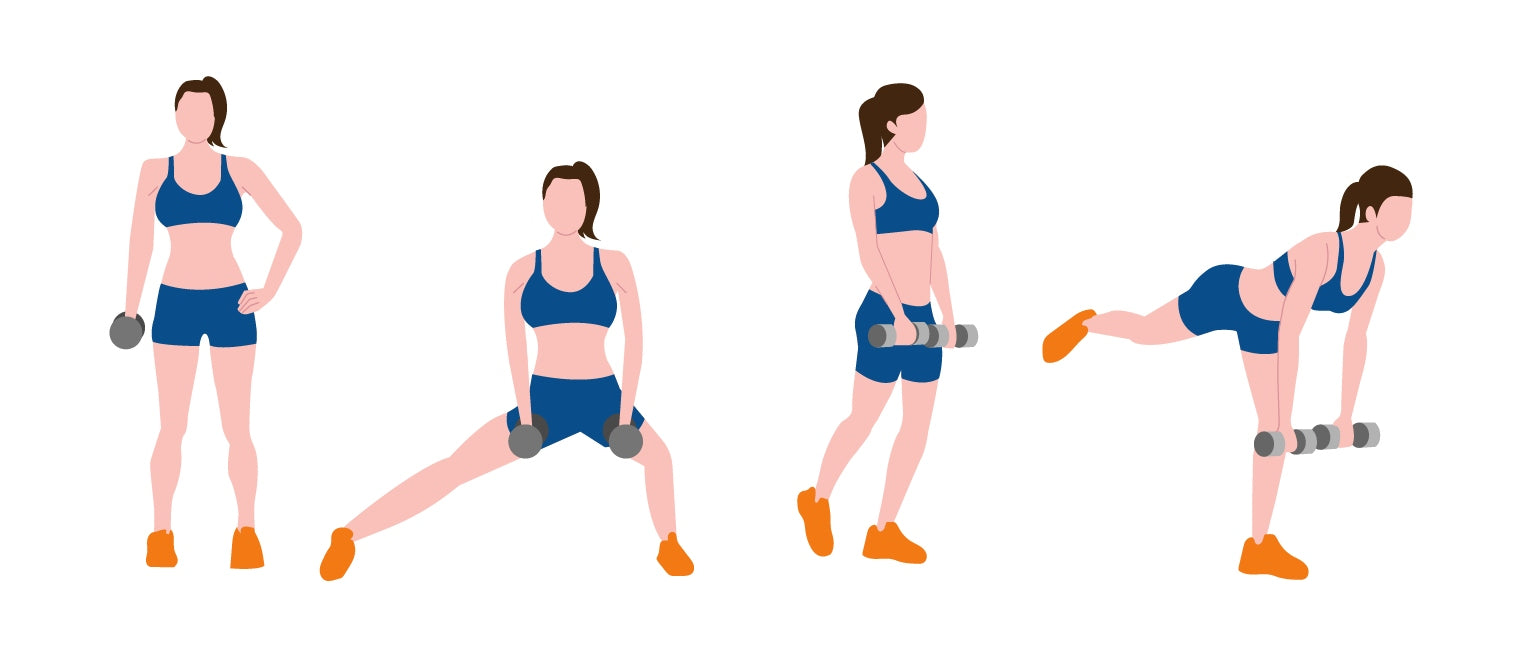
If you’re new to this exercise, then do it unweighted, but if you’re seasoned then grab two jars of Perform to weight up this exercise.
Start with your feet together and lunge to the side, keeping your knee over your toes. Staying low, engage your glutes and core and press back up through to center and then into a deadlift, reaching your leg behind you and your arms to the floor. Press back up to neutral. Do 20 reps on each side.
Burpees

Every good bodybuilding workout could use some high-intensity movement. Find your starting position: feet shoulder-width apart, weight in the heels, arms by your sides. As you lower into a squat, place your hands on the ground in front of you and jump your feet back into plank position. Then, jump your feet back to your hands and reach your arms overhead as you jump into the air. Shoot for 30 reps.
Glute Bridge
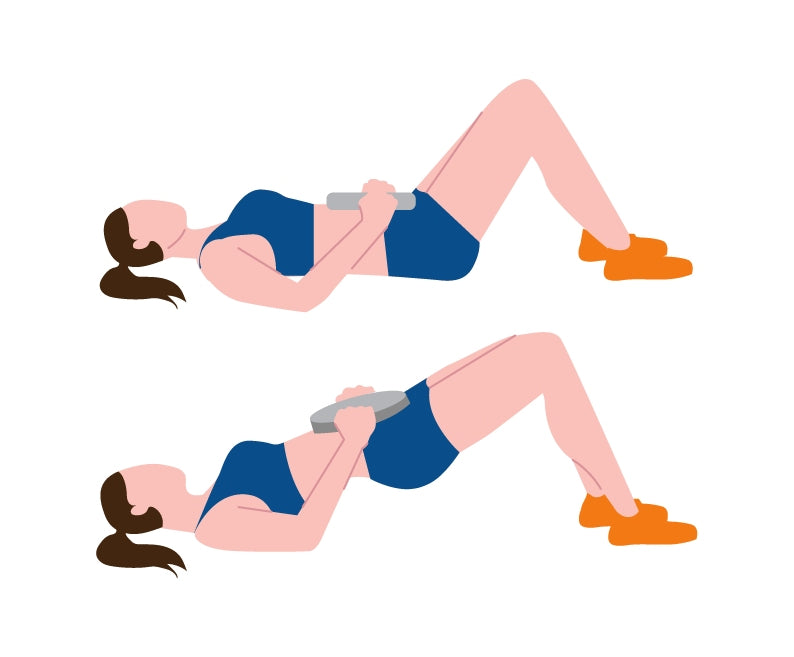
Lay on your back with your feet on the floor in bent-knee position, shoulder-width apart. Raise your hips to the ceiling while pushing your heels into the ground. Squeeze your glutes and keep your abs tight. Return to the original position. Do 50-100 reps to complete fatigue to get a great hamstring and glute workout.
You can just use your own bodyweight, or you can weight up your glute bridges. Use that heavy book!
Arm Exercises
Let’s move into the upper body to work our arms and abs. Every arm workout below engages the core for strong abdominal muscles.
Tricep Dips

You’ll need a chair for this exercise. Gripping the front edges of the chair, hover your butt in front of the seat with your feet flat, knees bent, and thighs parallel to the floor. Straighten your arms, then lower toward the floor, until your arms are at 90-degree angles. Press back to start, engaging your triceps through it all. Do 30-50 reps or to complete fatigue.
Pushups
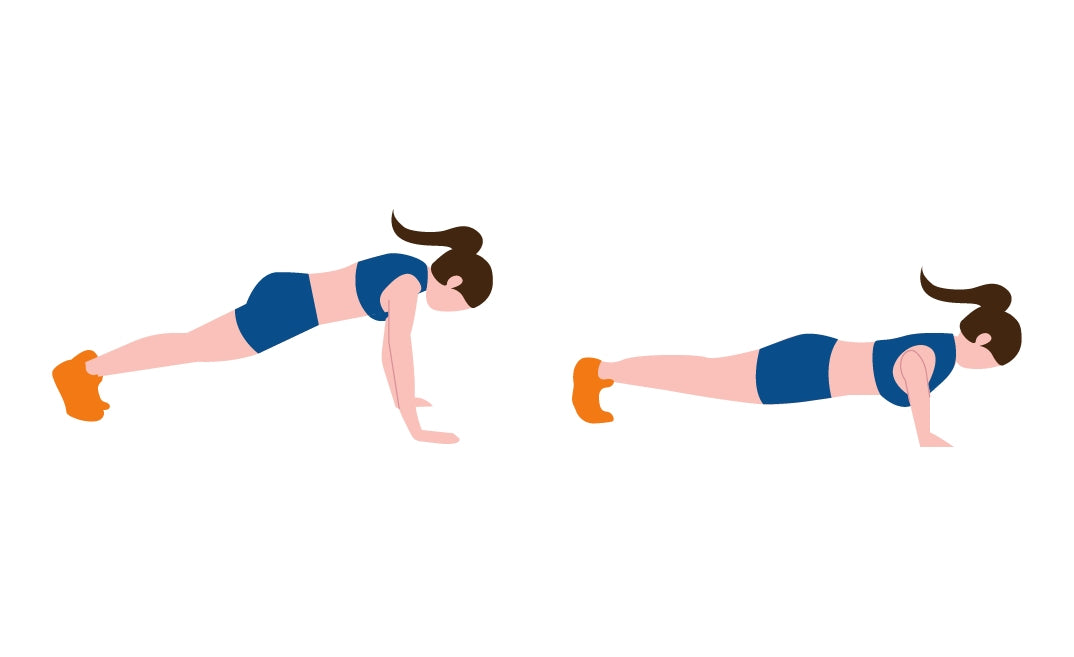
Time to get down on all fours for the classic pushup! The wider you have your arms and feet, the easier the pushup. From pushup position, lower your body until your chest hovers above the floor. Push back up and repeat for as many reps as you can until you reach complete fatigue.
Ready to level up from regular pushups? Try a pike pushup.

From plank position, lift your hips up so your body forms a V shape. Bend your elbows, lowering your upper body until your head hovers above the floor. Hold for a beat and then push back up. Repeat to exhaustion.
Table Bodyweight Row

Don’t have a pull-up bar? No problem. Here’s an alternative to pull-ups and chin-ups.
Laying on your back, grip either side of a sturdy table. Squeeze your shoulder blades together and pull upwards until your chest reaches the underside of the table. Lower a few inches to the ground and repeat to fatigue.
Handstand
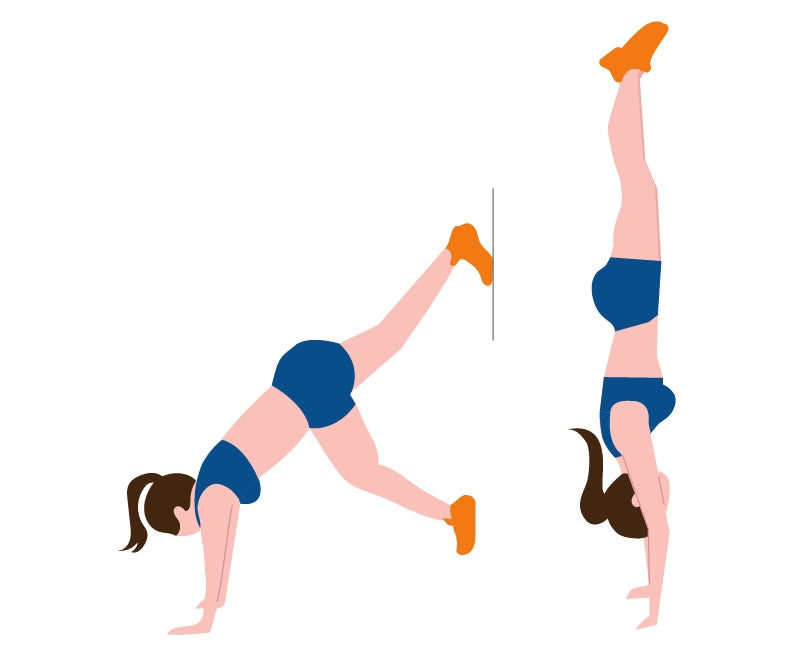
We don’t expect you to be a gymnast. Use a wall for support.
If you feel at ease, then face a wall and kick your legs up into handstand using the wall for balance. Hold as long as possible.
You can also get on all fours facing away from the wall and then carefully walk your legs up the walk into handstand position.
Plank Hold

Finish up your at-home workout with a 1-minute (or more!) plank hold. Be sure to keep your butt from hiking into the air and keep your shoulders in line with your arms.


Up to 25% off Amino
Shop NowTAGS: bodybuilding
Join the Community
Comments (0)
Most Craveable Recipes





 833-264-6620
833-264-6620





















